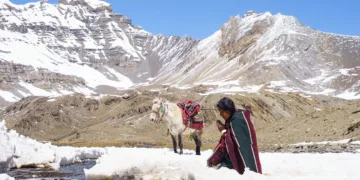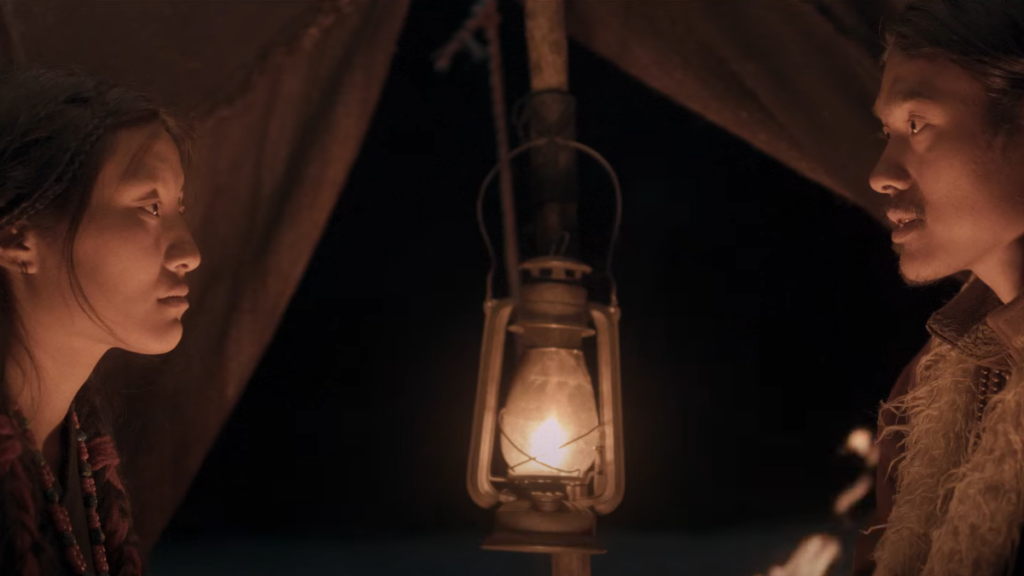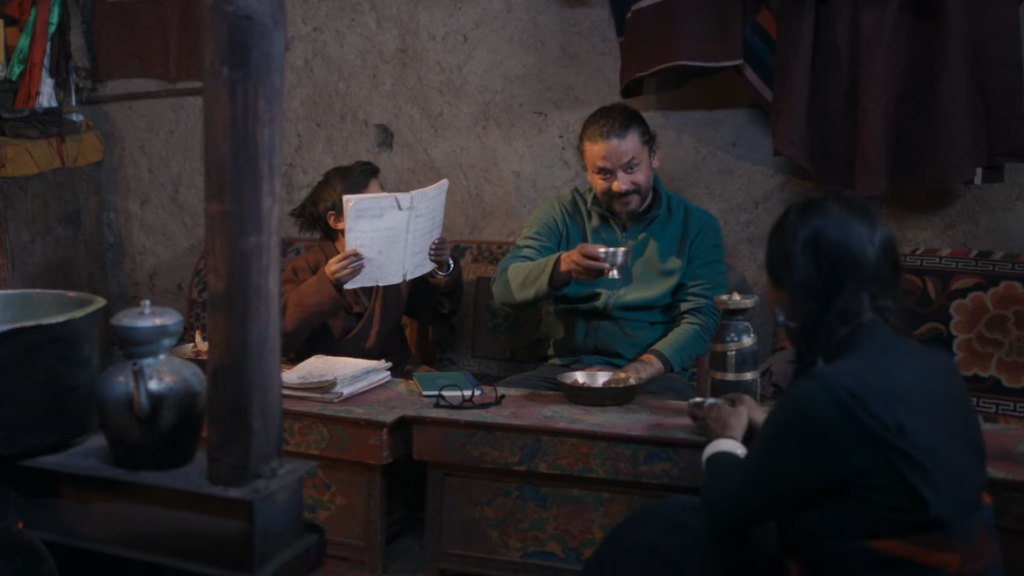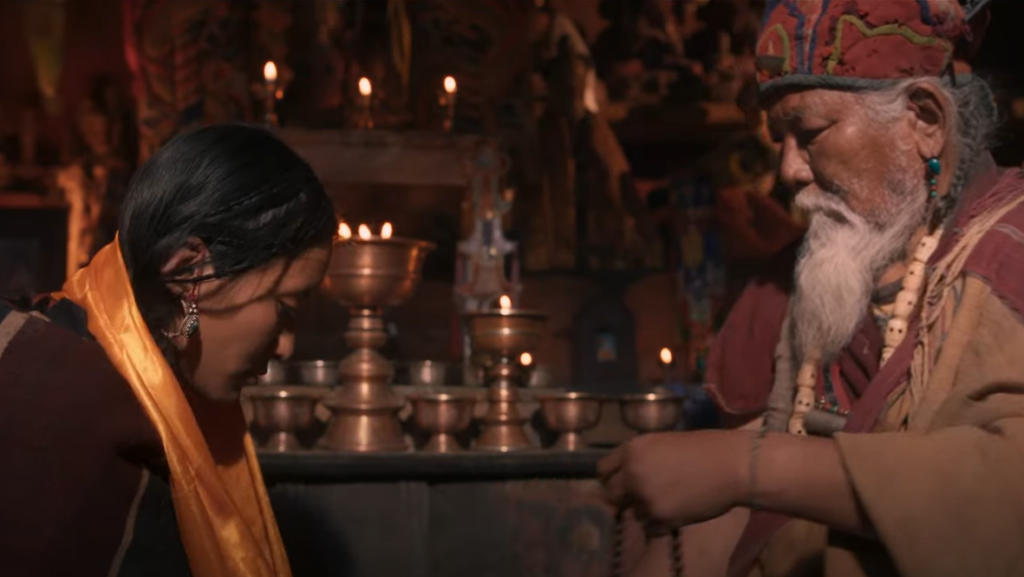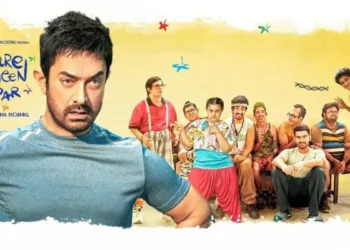Nepali director Min Bahadur Bham brings his homeland into the cinematic spotlight with Shambhala, the first film from the small Himalayan country to compete at a top-tier festival like Berlin. After honing his craft with the intimate family drama The Black Hen, Bham goes bigger and bolder here. We’re treated to the sweeping vistas of Nepal’s mountains as the backdrop for a surprisingly progressive romantic epic.
At the heart of the story is Pema, played with quiet strength by newcomer Thinley Lhamo. Newly married to village trader Tashi in a traditional polyandrous union, their domestic bliss turns tragic when Tashi vanishes amidst gossip questioning the paternity of Pema’s expected child. Facing scorn yet determined to reunite with her true love, Pema saddles up her steadfast horse Namkha and sets out on a daring journey across the very heavens Tashi once traversed.
Guiding her way is Tashi’s brother Karma, a devoted monk struggling between spiritual duty and earthly attachments. Through piercing snowstorms and winding mountain passes, the odd couple slowly bond as truths emerge that may unravel more than just the mystery of Tashi’s disappearance. Culminating in scenes of elemental beauty, Shambhala ultimately rewards those willing to surrender to its unhurried grace.
An Unlikely Pilgrimage
At the heart of Shambhala is Pema, a headstrong village woman played with captivating grace by newcomer Thinley Lhamo. She shocks her traditional Himalayan community by entering into a polyandrous marriage with three brothers from the village’s prominent farming family.
While unconventional to Western eyes, such plural unions help address the lack of women in these remote regions. Pema only has eyes for the handsome firstborn Tashi, while his brother Karma lives at the local monastery. Their sibling bond strains upon the arrival of the petulant youngest, adolescent Dawa, whose schoolboy crush on Pema causes no shortage of domestic tension.
After Tashi leaves to trade goods over hazardous mountain passes, lonely Pema finds herself the target of slut-shamingvillage gossip. Falsely accused of having an affair with Dawa’s teacher, she soon discovers she’s pregnant with Tashi’s child. But the damage is done. Word reaches Tashi about her alleged infidelity and he vanishes amidst shame and heartbreak somewhere along his homeward journey.
With scarcely more than her wits, her wisdom, and her steadfast horse Namkha, Pema sets out on an epic quest to track Tashi down. She aims to reclaim her good name and convince her lost love to return. Karma joins despite abandoning his monastic duties, partly out of family obligation and partly due to his awakening affection for his sister-in-law. Through one breathtaking landscape after another, director Bham transforms this couple’s unfolding emotional and spiritual voyage into a soaring testament to resilience in the face of injustice.
Love and Liberation in the Shadow of Everest
Beyond its sweeps of visual splendor, Shambhala examines timeless and universal themes of love, virtue, and the search for happiness. Pema and Tashi’s romance, while clouded by doubt, serves as an anchor. Their journey personifies the struggle to reconcile societal expectations with personal truths.
This is especially pronounced regarding the film’s feminist undertones. Early on, Pema’s wise father observes his free-spirited daughter can “do the work of both men and women.” Yet she soon endures the cruelty of the village rumor mill, a double standard where the burden of proving her innocence solely rests on Pema. Director Bham provocatively suggests the Buddhist tenets binding these communities perhaps fall short ensuring gender equality.
Juxtaposed is the ethnographic flavor with which Bham examines the region’s cultural rites. From trading caravans of wooly yaks along precarious cliffs to elaborately garbed monks debating philosophy in candlelit halls, he casts an intimate, non-judgmental eye studying lives foreign yet familiar. Magic interweaves through prophetic dreams and visions tied to Tibetan spirituality, including the mythical land of Shambhala itself.
Bham’s artistic approach mirrors this contrast between the tangible and the symbolic. He foregoes rapid cutting in favor of long static takes, some running three to four minutes with no cuts. The camera patiently pans across the vista, alternatively opening scenes up to the vast majesty of mountain peaks before zeroing in on the nuances of a lingering glance or slight curl of the lips. It’s an immersive experience certain to infuriate some yet enthrall those seeking a transportive escape.
Pema – The Beating Heart of Shambhala
While the Nepali landscape stuns in Shambhala, the true soul of the film is newcomer Thinley Lhamo as Pema. The camera loves Lhamo, whether she’s cradling baby goats, making steamed buns for her trio of husbands, or embarking on a death-defying mountain passage atop her noble horse Namkha. Technical limitations of Bham’s long extended takes require performers to live fully in the moment instead of relying on later editing tricks. Lhamo rises to the immense challenge, conveying silent strength and grace with each subtle shift of her eyes.
As gossip wrongly maligns Pema’s virtue and Tashi questions her fidelity, Lhamo externalizes the injustice through small gestures – a slight drop of the shoulders, a heavier gait up the mountain pass, fingers absently running through her hair. Yet her innate goodness persists no matter the indignities inflicted upon her, whether by scheming villagers or occasionally dubious in-laws. Audiences ride along feeling every spark of hope, each wound of betrayal, ultimately willing Pema to reclaim her good name.
By the final act, Bham suggests Pema herself has evolved into something more enlightened through her determination. She appears to channel the Buddhist teachings bound so intrinsically with these Eastern cultures yet so often weaponized exclusively against women like herself. As Shambhala arrives at its enigmatic yet empowering conclusion, Lhamo ensures we depart every bit as transformed as her emblematic heroine Pema.
An Imperfect Yet Rewarding Journey
Shambhala makes no apologies for what it is – a visually resplendent, defiantly unhurried immersion into an seldom-glimpsed world. Nepali director Bham purposefully tosses rapid-fire editing techniques aside, instead allowing scenes to breathe and unfold at their own pace. This meditative approach rewards patient viewers with an intimate voyage exploring the extremes of both environment and emotion.
Central to its success lies Thinley Lhamo’s raw yet affecting lead performance as the resilient Pema. By experiencing the injustice she endures, audiences access larger truths about virtue, community, and gender roles in traditional Himalayan life. Bham suggests spiritual freedom perhaps arrives not from blindly accepting external beliefs but from looking inward and determining one’s own path.
Make no mistake – lovers of conventional three-act cinematic structure may bristle at the leisurely proceedings. Yet fans of art house fare and exploratory cinema will discover much to enjoy. Shambhala works best taken on its own terms – an imperfect tone poem celebrating the redemptive power of the human spirit against landscapes as divinely breathtaking as the journey is demanding. For such patient viewers, this deliberately-paced Nepali epic offers rewards as rich as its gorgeous vistas.
The Review
Shambhala
Shambhala requires patience to unlock its visual poetry and intimate exploration of an unseen world. Those willing to surrender to its unhurried pace will discover a film both sweepingly gorgeous and thematically profound.
PROS
- Breathtaking cinematography showing the beauty of Nepal
- Captivating lead performance by Thinley Lhamo
- Unique glimpse into unfamiliar Himalayan culture and traditions
- Thoughtful themes related to gender roles, spirituality, redemption
- Ambitious and poetic artistic vision by director
CONS
- Very slow, meditative pacing that tests viewer patience
- Overly long running time of 150 minutes
- Plot can be thin and meandering at times
- May confuse viewers unfamiliar with Tibetan Buddhism
- Uneven tonal shifts between ethnographic study and melodrama
